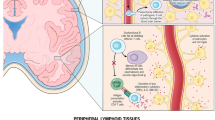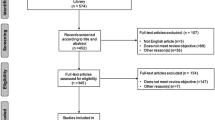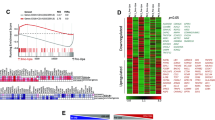Abstract
Glatiramer acetate (GA) is an approved immunomodulating agent for the treatment of relapsing–remitting multiple sclerosis. Its mode of action is attributed to a T helper cell-type 1 (Th1) to Th2 cytokine shift in T cells. Th2-type GA-reactive T cells migrate into the brain and act suppressive at the sites of inflammation. However, there is increasing evidence that the effect of GA is not confined to T cells. It inhibits broadly the activation of monocytes and induces peritoneal macrophages and monocytes to differentiate into a type 2 antigen-presenting cell (APC) secreting anti-inflammatory cytokines. Thus, we examined whether GA has also direct effects on microglia cells which are involved in modifying/directing the local microenvironment in the central nervous system. Primary rat microglia were purified and cultured under standard conditions. Griess reaction was used to measure one of the stable end products of nitric oxide (NO), nitrite. Tumor necrosis factor (TNF)-alpha and interleukin-10 (IL-10) were measured in the cell culture supernatants using ELISA. Phagocytosis was quantified with a FACS-based assay. Our experiments show that GA directly modulates microglia cells. It promotes the phagocytic activity and increases the secretion of IL-10 while it decreases that of TNFα. In contrast, there was no effect on NO production. GA induces a type 2 APC differentiation of microglia suggesting a general effect on myeloid monocytic cells. Using microglia we report for the first time that GA promotes phagocytosis which could play an important role in removal of debris.






Similar content being viewed by others
References
Aharoni R, Teitelbaum D, Sela M, Arnon R (1997) Copolymer 1 induces T cells of the T helper type 2 that crossreact with myelin basic protein and suppress experimental autoimmune encephalomyelitis. Proc Natl Acad Sci USA 94:10821–10826
Aharoni R, Teitelbaum D, Sela M, Arnon R (1998) Bystander suppression of experimental autoimmune encephalomyelitis by T cell lines and clones of the Th2 type induced by copolymer 1. J Neuroimmunol 91:135–146
Aharoni R, Teitelbaum D, Leitner O, Meshorer A, Sela M, Arnon R (2000) Specific Th2 cells accumulate in the central nervous system of mice protected against experimental autoimmune encephalomyelitis by copolymer 1. Proc Natl Acad Sci USA 97:11472–11477
Aharoni R, Arnon R, Eilam R (2005) Neurogenesis and neuroprotection induced by peripheral immunomodulatory treatment of experimental autoimmune encephalomyelitis. J Neurosci 25:8217–8228
Aharoni R, Herschkovitz A, Eilam R, Blumberg-Hazan M, Sela M, Bruck W, Arnon R (2008) Demyelination arrest and remyelination induced by glatiramer acetate treatment of experimental autoimmune encephalomyelitis. Proc Natl Acad Sci USA 105:11358–11363
Arnon R, Aharoni R (2004) Mechanism of action of glatiramer acetate in multiple sclerosis and its potential for the development of new applications. Proc Natl Acad Sci USA 101(Suppl 2):14593–14598
Burger D, Molnarfi N, Weber MS, Brandt KJ, Benkhoucha M, Gruaz L, Chofflon M, Zamvil SS, Lalive PH (2009) Glatiramer acetate increases IL-1 receptor antagonist but decreases T cell-induced IL-1beta in human monocytes and multiple sclerosis. Proc Natl Acad Sci USA 106:4355–4359
Capsoni F, Minonzio F, Ongari AM, Carbonelli V, Galli A, Zanussi C (1995) IL-10 up-regulates human monocyte phagocytosis in the presence of IL-4 and IFN-gamma. J Leukoc Biol 58:351–358
Capsoni F, Minonzio F, Mariani C, Ongari AM, Bonara P, Fiorelli G (1998) Development of phagocytic function of cultured human monocytes is regulated by cell surface IL-10. Cell Immunol 189:51–59
Carson MJ, Doose JM, Melchior B, Schmid CD, Ploix CC (2006) CNS immune privilege: hiding in plain sight. Immunol Rev 213:48–65
Chabot S, Yong FP, Le DM, Metz LM, Myles T, Yong VW (2002) Cytokine production in T lymphocyte-microglia interaction is attenuated by glatiramer acetate: a mechanism for therapeutic efficacy in multiple sclerosis. Mult Scler 8:299–306
Chen MS, Huber AB, van der Haar ME, Frank M, Schnell L, Spillmann AA, Christ F, Schwab ME (2000) Nogo-A is a myelin-associated neurite outgrowth inhibitor and an antigen for monoclonal antibody IN-1. Nature 403:434–439
Duda PW, Schmied MC, Cook SL, Krieger JI, Hafler DA (2000) Glatiramer acetate (Copaxone) induces degenerate, Th2-polarized immune responses in patients with multiple sclerosis. J Clin Invest 105:967–976
Giulian D, Baker TJ (1986) Characterization of ameboid microglia isolated from developing mammalian brain. J Neurosci 6:2163–2178
Hata K, Fujitani M, Yasuda Y, Doya H, Saito T, Yamagishi S, Mueller BK, Yamashita T (2006) RGMa inhibition promotes axonal growth and recovery after spinal cord injury. J Cell Biol 173:47–58
Holzknecht C, Rohl C (2010) Effects of methylprednisolone and glatiramer acetate on nitric oxide formation of cytokine-stimulated cells from the rat oligodendroglial cell line OLN-93. Neuroimmunomodulation 17:23–30
Hussien Y, Sanna A, Soderstrom M, Link H, Huang YM (2001) Glatiramer acetate and IFN-beta act on dendritic cells in multiple sclerosis. J Neuroimmunol 121:102–110
Iarlori C, Gambi D, Lugaresi A, Patruno A, Felaco M, Salvatore M, Speranza L, Reale M (2008) Reduction of free radicals in multiple sclerosis: effect of glatiramer acetate (Copaxone). Mult Scler 14:739–748
Johnson KP, Brooks BR, Cohen JA, Ford CC, Goldstein J, Lisak RP, Myers LW, Panitch HS, Rose JW, Schiffer RB (1995) Copolymer 1 reduces relapse rate and improves disability in relapsing–remitting multiple sclerosis: results of a phase III multicenter, double-blind placebo-controlled trial. The Copolymer 1 Multiple Sclerosis Study Group. Neurology 45:1268–1276
Jung S, Siglienti I, Grauer O, Magnus T, Scarlato G, Toyka K (2004) Induction of IL-10 in rat peritoneal macrophages and dendritic cells by glatiramer acetate. J Neuroimmunol 148:63–73
Kim HJ, Ifergan I, Antel JP, Seguin R, Duddy M, Lapierre Y, Jalili F, Bar-Or A (2004) Type 2 monocyte and microglia differentiation mediated by glatiramer acetate therapy in patients with multiple sclerosis. J Immunol 172:7144–7153
Kotter MR, Li WW, Zhao C, Franklin RJ (2006) Myelin impairs CNS remyelination by inhibiting oligodendrocyte precursor cell differentiation. J Neurosci 26:328–332
Liblau R (2009) Glatiramer acetate for the treatment of multiple sclerosis: evidence for a dual anti-inflammatory and neuroprotective role. J Neurol Sci 287(Suppl 1):S17–S23
Lingnau M, Hoflich C, Volk HD, Sabat R, Docke WD (2007) Interleukin-10 enhances the CD14-dependent phagocytosis of bacteria and apoptotic cells by human monocytes. Hum Immunol 68:730–738
Liu J, Johnson TV, Lin J, Ramirez SH, Bronich TK, Caplan S, Persidsky Y, Gendelman HE, Kipnis J (2007) T cell independent mechanism for copolymer-1-induced neuroprotection. Eur J Immunol 37:3143–3154
Marik C, Felts PA, Bauer J, Lassmann H, Smith KJ (2007) Lesion genesis in a subset of patients with multiple sclerosis: a role for innate immunity? Brain 130:2800–2815
Mukhopadhyay G, Doherty P, Walsh FS, Crocker PR, Filbin MT (1994) A novel role for myelin-associated glycoprotein as an inhibitor of axonal regeneration. Neuron 13:757–767
Neuhaus O, Farina C, Yassouridis A, Wiendl H, Then BF, Dose T, Wekerle H, Hohlfeld R (2000) Multiple sclerosis: comparison of copolymer-1- reactive T cell lines from treated and untreated subjects reveals cytokine shift from T helper 1 to T helper 2 cells. Proc Natl Acad Sci USA 97:7452–7457
Pul R, Nguyen D, Schmitz U, Marx P, Stangel M (2002) Comparison of intravenous immunoglobulin preparations on microglial function in vitro: more potent immunomodulatory capacity of an IgM/IgA-enriched preparation. Clin Neuropharmacol 25:254–259
Sawada M, Kondo N, Suzumura A, Marunouchi T (1989) Production of tumor necrosis factor-alpha by microglia and astrocytes in culture. Brain Res 491:394–397
Stangel M, Compston A (2001) Polyclonal immunoglobulins (IVIg) modulate nitric oxide production and microglial functions in vitro via Fc receptors. J Neuroimmunol 112:63–71
Stangel M, Joly E, Scolding NJ, Compston DA (2000) Normal polyclonal immunoglobulins ('IVIg') inhibit microglial phagocytosis in vitro. J Neuroimmunol 106:137–144
Stapulionis R, Oliveira CL, Gjelstrup MC, Pedersen JS, Hokland ME, Hoffmann SV, Poulsen K, Jacobsen C, Vorup-Jensen T (2008) Structural insight into the function of myelin basic protein as a ligand for integrin alpha M beta 2. J Immunol 180:3946–3956
Vieira PL, Heystek HC, Wormmeester J, Wierenga EA, Kapsenberg ML (2003) Glatiramer acetate (copolymer-1, copaxone) promotes Th2 cell development and increased IL-10 production through modulation of dendritic cells. J Immunol 170:4483–4488
von Zahn J, Moller T, Kettenmann H, Nolte C (1997) Microglial phagocytosis is modulated by pro- and anti-inflammatory cytokines. NeuroReport 8:3851–3856
Wang KC, Koprivica V, Kim JA, Sivasankaran R, Guo Y, Neve RL, He Z (2002) Oligodendrocyte-myelin glycoprotein is a Nogo receptor ligand that inhibits neurite outgrowth. Nature 417:941–944
Weber MS, Starck M, Wagenpfeil S, Meinl E, Hohlfeld R, Farina C (2004) Multiple sclerosis: glatiramer acetate inhibits monocyte reactivity in vitro and in vivo. Brain 127:1370–1378
Weber MS, Prod'homme T, Youssef S, Dunn SE, Rundle CD, Lee L, Patarroyo JC, Stuve O, Sobel RA, Steinman L, Zamvil SS (2007) Type II monocytes modulate T cell-mediated central nervous system autoimmune disease. Nat Med 13:935–943
Wiesemann E, Klatt J, Sonmez D, Blasczyk R, Heidenreich F, Windhagen A (2001) Glatiramer acetate (GA) induces IL-13/IL-5 secretion in naive T cells. J Neuroimmunol 119:137–144
Yang L, Anderson DE, Kuchroo J, Hafler DA (2008) Lack of TIM-3 immunoregulation in multiple sclerosis. J Immunol 180:4409–4414
Ziemssen T, Kumpfel T, Klinkert WE, Neuhaus O, Hohlfeld R (2002) Glatiramer acetate-specific T-helper 1- and 2-type cell lines produce BDNF: implications for multiple sclerosis therapy. Brain-derived neurotrophic factor. Brain 125:2381–2391
Acknowledgement
We thank Ilona Cierpka-Leja for excellent technical assistance. JŠ was supported by a Georg-Christoph-Lichtenberg Fellowship by the State of Lower Saxony.
Author information
Authors and Affiliations
Corresponding author
Additional information
Martin Stangel and Refik Pul are guarantors of the work.
All authors declare that they have no competing interests.
Rights and permissions
About this article
Cite this article
Pul, R., Moharregh-Khiabani, D., Škuljec, J. et al. Glatiramer Acetate Modulates TNF-α and IL-10 Secretion in Microglia and Promotes Their Phagocytic Activity. J Neuroimmune Pharmacol 6, 381–388 (2011). https://doi.org/10.1007/s11481-010-9248-1
Received:
Accepted:
Published:
Issue Date:
DOI: https://doi.org/10.1007/s11481-010-9248-1




